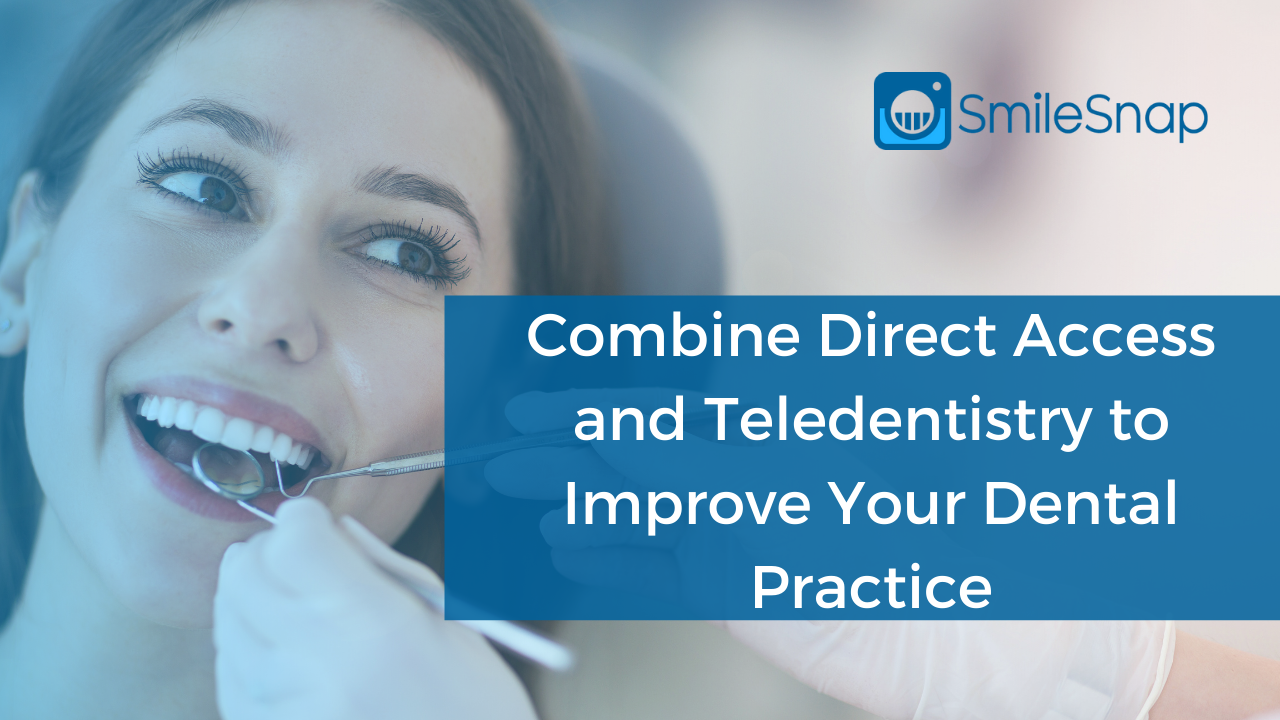Combine Direct Access and Teledentistry to Improve Your Dental Practice

As of 2021, 42 states allow direct access, allowing dental hygienists to practice oral health without a dentist being present. When dentists take advantage of direct access in their practices, they free themselves up to provide teledentistry services to patients who prefer online dental consults. The combination of direct access and teledentistry can make your dental practice more efficient and more profitable.
What is direct access?
With direct access, patients can choose to be treated by a dental hygienist or dental professional without needing the supervision or prescription of a dentist.
Every state has different regulations and supervision levels ranging from direct supervision where the dentist must be present to general supervision, where the dentist can authorize services but does not need to be present.
Some of these oral health services include:
- Oral Prophylaxis
- Dental Hygiene Assessment
- Soft Tissue Curettage
- Topical Anesthesia
- Fluoride
- Dental Hygiene Diagnosis
- Scaling and Root Planing
- Local Anesthesia
- Place and Remove Perio Dressings
- Administer N2O
- Pit/Fissure Sealants
- Study Cast Impressions
- Place and Remove Sutures
- X-Rays
- Treatment Planning
- Prescriptive Authority
General supervision is allowed in most states. In California, for example, dental hygienists may apply dental sealants and fluorides and screen patients without supervision.
Other states, like Colorado, allow a more comprehensive scope of care. There, dental hygienists can practice without the direct supervision of a dentist and can perform tasks like periodontal charting, administering x-rays, scaling and root planing, and offering oral health diagnoses and treatment plans.
Who can treat patients?
Outside of professional teeth whitening, a dental hygienist can see and treat patients directly.
Teeth whitening requires a prescription that a dentist must carry out.
Is direct access mandatory?
If a dental practice wishes to continue their current working layout, they are not required to change anything. Direct access is not compulsory; for many dental offices, this service is only offered to patients when there is a mutual agreement between the dental hygienist and the dentist.
What services can a dental hygienist provide?
Becoming a dental hygienist can require years of education and training. Many must be actively engaged in dentistry for at least five hundred hours in the two years before working with a dental practice.
Dental hygienists who have earned a bachelor’s degree in dental hygiene along with an active license with the last three years may also qualify for affiliated practice. They are also trained in medical emergency procedures, including basic cardiopulmonary resuscitation.
The dental hygienist works hard to improve and enhance the oral health of patients. While services can range from state to state, some procedures provided by a dental hygienist may include:
- Screening patients and assessing oral health conditions
- Reviewing medical history
- Screening for oral cancer
- Taking blood pressure and pulse
- Inspecting head and neck
- Dental charting
- Administering x-rays
- Removing the build-up of plaque and calculus
- Applying dental sealants and fluoride to teeth
- Going over oral hygiene techniques such as proper brushing and flossing
- Discussing good nutrition and how diet can impact oral health
- Making impressions of teeth
- Documenting patient care
Direct access can impact dental hygienists as they may no longer need a written prescription from a dentist prior to patient treatment. However, they are entirely responsible for diagnosing and treating.
Furthermore, dental hygienists are no longer limited to perform a treatment plan if they choose not to. They are fully entitled to carry out treatment as their skills and experience see fit, and they are accountable for any decisions they make.
Benefits of Direct Access
Direct access allows dental hygienists to treat and make assessments without the special authorization of a dentist.
Increasing Access to Preventive and Restorative Dentistry
Most states contain federally classified Dental Health Professional Shortage Areas, which signify which population groups and areas do not have enough dental health professionals to serve the needs of the community. Federal regulations hold that the population-to-provider ratio should be at least 5,000 to 1 to be classified as a dental shortage area.
In Texas, for example, which ranks 47th in the United States, 406 dentists are needed to remove the dental HPSA deficiency as of June 30, 2020. In 57 Texas counties, there are no general dentists, while in 30 others, there is only one.
Patients who live in underserved or rural parts of the country can significantly benefit from direct access. Whether under direct or indirect supervision, dental hygienists and other dental professionals can broaden access to dental health care in communities with less access or ability to pay for dentists. Dental hygienists offer a practical alternative for clinics seeking to accommodate all patients.
More Cost-Effective for Patients
Even modest cost savings can mean the difference between regular oral examinations and going without. Dentists can utilize their time engaging in virtual consultations or handling complex oral health issues while dental hygienists and trained dental professionals can focus on basic preventive services.
The Importance of Direct Access
All American citizens should have access to healthcare and dental care. If the current dentist shortage worsens, it’s essential to allow Americans access to dental care as populations continue to boom. Direct access care can address dentist shortage issues, especially in underserved and underrepresented population groups.
How Teledentistry with SmileSnap and Direct Access Work Together
The combination of teledentistry and direct access is perfect for dentists who want to use their time more efficiently and make their practices more profitable while meeting unique patient needs. While a dental hygienist provides care to in-person patients, dentists can use that time to meet with patients virtually.
Teledentistry visits typically take between 15 and 30 minutes. These appointments usually consist of initial consultations with new patients, follow-up visits for recurring patients, or consulting with patients about their current symptoms. While dentists cannot perform any treatments during these consultations, they can gather the information they need to put a treatment plan together and schedule an in-person appointment with the patient.
Teledentistry isn’t just convenient and profitable for you, it is convenient and more affordable for patients. This means patients are much more likely to meet with you online than they would be in person.
About SmileSnap
Want to ensure your virtual dental consultations go as smoothly as possible? SmileSnap software is a HIPPA-compliant widget that can be added seamlessly to your website. Our easy-to-use, customizable software enables patients to submit information and pictures directly to your office in a safe and convenient way. Then, patients can meet with you virtually to discuss their smile goals or any concerning symptoms.
SmileSnap helps dentists turn potential patients into recurring ones. Patients will be able to easily navigate through your website and the appropriate portals to submit information or to enter into a video call. Patients expect these types of visits to be glitch-free, fast, and self-explanatory. With SmileSnap, that’s exactly what they get.
In this ongoing pandemic, dentists need a simple virtual tool that helps them meet patients’ needs without compromising anyone’s health. SmileSnap is the answer.
To learn more about our software, or to add virtual dental consult capability to your practices, contact our team today at
1-720-738-8080.
Sign Up for SmileSnap Today!
Register for Smilesnap Now!


